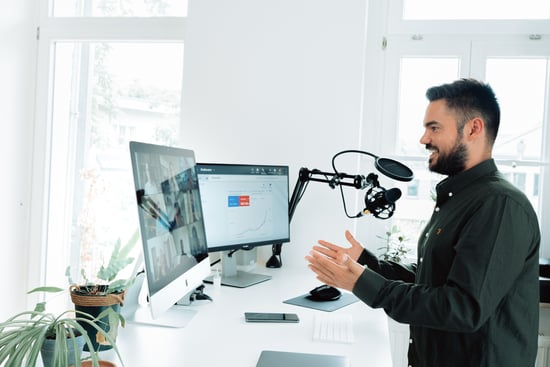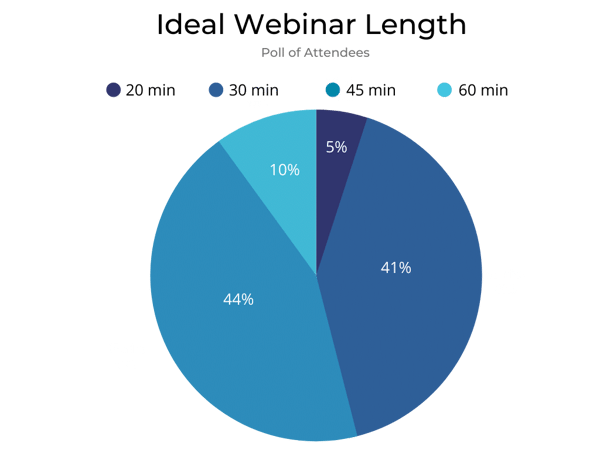7 Steps to Create an Engaging Marketing Webinar That Will Generate a Ton of Leads
It is an art to create a webinar that leaves your audience inspired and ready to be pushed down the conversion funnel. Crossing over the fine line between an average webinar and a great one can lead to genuine engagement and long-lasting relationships. If done right, a webinar has the potential to impact your bottom line, as webinar marketing is a powerful tool, disguised intelligently as a learning tool.
Webinars were, in fact, introduced as educational webcasts for remote learners. Now, they have a myriad of applications from brand awareness, lead generation, new product promotion, and even direct sales.
Webinars can move the needle in the sales process more than anything else in your marketing arsenal. Of those who use webinars as a marketing tool, 85% of them say that webinars are crucial for their marketing efforts and 67% of marketers were increasing their investment in webinars in 2021.

Here are 7 steps to follow that can help you create a webinar from scratch, that will provide immediate engagement and tons of leads:
1. Determine your idea
It isn’t the best idea to host a webinar on a generic topic. Choose a topic that is highly specialized and that you can go into in great detail. This will help you keep the webinar focused and your audience’s attention won’t waver, as you’ll have minimal chance of going off on tangents. For example, instead of a webinar on a vastly broad subject like the Internet of Things development, you could choose a specific topic like how to choose the best smart home security system.
Along with the subject, before you design your webinar, be clear about your goals. One of the more common content marketing mishaps is to not identify your goals. Do you want to simply educate people about smart home security systems, or perhaps eventually make a sale. The purpose of your webinar is of immense importance because that is what will help you gauge its success.
The purpose also helps you identify your audience. Once you’re aware of who your target audience is, you can create a webinar that offers value specific to them and makes it worth their time.
2. Choose your format
Webinars can be conducted in many different ways. Here are the options, choose the one that matches your individual circumstances best:
Single or Dual Speaker(s)
You can choose a single presenter to host the entire webinar if you want, although co-hosting a webinar is also common and is often favored because there is a natural conversational flow between two presenters. It also allows them to relax, because if one pauses for a moment, the other one can take over. The single-speaker format is preferred if you have a small audience or if the speaker is a compelling presenter well versed in their topic. You can also have one speaker, who presents the webinar and one expert who answers questions.
Panel of experts
You can have a moderated panel discussion to offer your audience varied voices and perspectives. It is one of the more powerful webinar formats and the one that offers the most learning. Having many experts on your panel increases active audience participation. The experts can be in-house or a guest who is the subject expert.
Interview format
There are two people in this webinar. One is a speaker, perhaps a subject matter expert, the other asks them predetermined questions.
Q&A webinar
The audience asks questions via chat or social media. This is a highly engaging format and shows your audience that you’re concerned about their pain points and are ready to help. Usually, Q&A segments are added at the end of every webinar.

3. Choose the right speakers and assign roles to your team
Audiences are perceptive, so choose a speaker who knows what they’re talking about. Find your own in-house experts or hire them externally. They should be authoritative, confident, and comfortable talking on camera. If, for example, your webinar is about enterprise communication systems, make sure you have an expert speaker who knows everything about it from team messaging apps, phone statuses, video conferencing, and file sharing.
Every webinar needs a facilitator or organizer. Someone who takes full responsibility for creating the content, finding the right speakers, and promoting the event. The organizer has to ensure smooth registrations and communicate with the participants at the beginning and end of the webinar.
You will also need to enlist technical assistants. This will help you focus on the presentation so there is someone to take care of the inevitable technical problems. For large audiences, you may also need people assigned to help monitor chat.
4. Promote your webinar
The webinar might have brilliant content and be meticulously planned, but it won’t promote itself. Publicize it. You could consider social media, your blog, SEO, AI for contact centers, or even email people about it. Find trusted partners to associate with for the webinar and consider co-marketing opportunities. If you want maximum participation, make sure to market your webinar.
Your website should be the first place to start. Create a landing page for the event and allow website visitors to sign up for the webinar. Once you have their email address, you can send them an email to say that they have successfully registered. You can later send a reminder as the webinar gets close. Your website should also have a banner or an ad on its homepage to ensure all visitors are aware of the upcoming webinar.
Create a buzz around your webinar at least 2 weeks before the event.
5. Create a mind-blowing presentation and script
Your slide deck can’t be yawn-inducing, as that would kill the entire purpose of a webinar. Your digital presentation should support and enhance your webinar script. It should strengthen the points you make and not be a replication of what you’re saying. Use the presentation to add multimedia to your talk. Images, videos, memes, etc. all can add value and keep your presentation from being dry and bland.
Don’t host a webinar without a script. Even the most skilled professionals rely on scripts because talking to convince someone is hard work. The logistics of your speech are greatly improved if you have a script that you have practiced. It also helps minimize simply reading off of the slide deck and avoids repetition.

6. Technological considerations to make
Foremost, find a quiet room to conduct the webinar from. Then, ensure the following to conduct the perfect webinar:
- Select the right equipment. Use cabled headset microphones.
- Ensure your laptop is charged and keep a spare fully charged.
- Make sure videos on your slides work and don’t take time to load.
- Choose an HD camera for high picture quality.
- Consider live streaming on YouTube or Facebook. Live chat is great and social media platforms are virtually free.
- Perform an internet speed test.
- Run a test webinar to ensure everything works cohesively.

7. Run your webinar
Whether you’re launching a new product or announcing software pricing models, be prepared with everything at least 20 minutes before the webinar is scheduled to begin. Being early helps you feel relaxed.
Practice how much time you take to present and don’t be afraid to cut down on your material to stay within the time limit. Ensure you keep at least 10 minutes in the end for audience questions.
It would be best if you accept that something or other will go wrong. Come to terms with it so you don’t get nervous when things go south. Crack a joke to relieve the tension after an inevitable hiccup occurs.
Knowing your audience is essential to establishing a connection with them. You don’t need to know their names but before the webinar, have a quick look at who is in the audience so you can acknowledge the crowd. Encourage questions and don’t be overwhelmed with the more complex ones.

Learn from your mistakes to refine your webinar and then automate it
After the webinar, debrief with your team. Discuss what you did right and how you can improve webinar engagement for next time. Follow up with your attendees. It is one of the best opportunities to continue engaging with your audience. According to experts from reputation management companies, this will help encourage them to attend future webinars and increase brand awareness.
If the content of your webinar is evergreen and something you plan to present many times over, spend the time to iteratively improve the experience after every session. Pay attention to questions that come up repeatedly, points of confusion that require clarification, and what sections seem to work best. Take everything you learn and work it back into your webinar. For sales and marketing webinars, the ultimate goal will be to increase your conversion rate, whether that’s an email opt-in of some kind or an actual purchase.
Similar to the process of transcription for call center, you can have the webinar transcribed, so you have your words in writing. This can help you check if your script needs improvement and if you followed it properly.
Just like Amazon Vine reviews, you could ask webinar attendees to leave honest reviews of the webinar on its landing page. These will also give you insight into how you can make the webinar better..
After you have presented the webinar several times, if you find you are able to anticipate the majority of questions and, in the case of sales webinars, your conversation rate is healthy and reliable, you should probably consider webinar automation. This will let you offer unlimited sessions without sacrificing the interactivity and engagement that make live webinars powerful, provided you use the right automated webinar software, like eWebinar.
In the end, an outstanding webinar must be well planned and organized by a closely-knit team. Plan your webinar well and use every iteration to improve it and achieve excellence.




.png.webp?width=70&height=70)



